nimgoldman
Hazard to Others
  
Posts: 303
Registered: 11-6-2018
Member Is Offline
|
|
Production of Ammonia (Solution)
It seems the easiest way to obtain pure ammonia solution is to produce ammonia gas and dissolve it in water. I followed the procedure from PrepChem.
I've set up the apparatus (see image), from left: ammonia generator (containing mixed equal amounts of calcium hydroxide and ammonium chloride), wash
bottle (to catch particles and some excess water vapour), receiver flask (chilled to improve absorption of the gas), wash bottle (to trap excess
ammonia and monitor the rate of absorbtion).
As expected, the last bottle bubbled until all the air was flushed out. It then stopped bubbling and I can see all the generated gas was dissolved.
Ideally, the generator should have produced 34 grams of ammonia (based on 50 g of ammonium chloride used).
Since I used 250 g of water, the maximum concentration is 13.6%
I measured density of the solution and the concentration was only 2.8%
I am now thinking how to improve efficiency. I saw Cody's lab Video, where he dissolved the reagents in water and boiled the mixture.
I don't know why Cody chose this approach (to remove the insoluble salt formed?) since boiling water to get ammonia will always leave some in the
water. On the other hand, one cannot overheat the flask like with heating dry powders.
I was also thinking about boiling the aqueous reaction mixture, but scrubbing the water using a reflux condenser, then driving the gas in the chilled
receiver.
Of course, one can let the water come over, but that would dilute the water in the receiver and carry over impurities.
I would welcome any ideas on improving the ammonia water production. Sice I'd like to easily produce about a liter of 25-30% solution.
Yet another option would be simply buying ammonia water (technical grade) and using the generated gas to saturate distilled water.
I have the reagents at hand at high quantity, so I would like to use the NH4Cl + Ca(OH)2 approach.
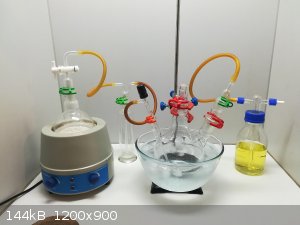 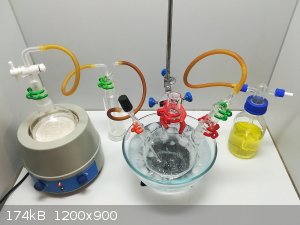
[Edited on 12-11-2018 by nimgoldman]
|
|
|
Deathunter88
National Hazard
   
Posts: 508
Registered: 20-2-2015
Location: Beijing, China
Member Is Offline
Mood: No Mood
|
|
As a general rule, you don't want to do solid chemistry if you can avoid it (ie. mixture of powders) because the surface area in contact will limit
your yield. In your case, try heating your mixture wet with just enough water to form a slurry. You will likely get a much higher yield.
|
|
|
Assured Fish
Hazard to Others
  
Posts: 319
Registered: 31-8-2015
Location: Noo Z Land
Member Is Offline
Mood: Misanthropic
|
|
Someone should probably note how much of an affinity for water ammonia has, this is problematic for ammonia generators with suck back being a real
issue.
It seems the water is willing to pull itself into your apparatus just to disolve the ammonia gas. To avoid this might i strongly suggest putting some
kind of suck back prevention in between your ammonia source and the solution to which you are trying to disolve the ammonia.
Your wash bottle will not surfice as this has a tube comming from the ammonia source all the way dpwn to the bottom of the wash bottle, so any water
that flows into this wash bottle is gonna go straight up that tube and into your hot reaction vessel.
Copious ammounts of cold water flowing into a hot flask is great way to destroy expensive glassware.
As deathhunter also pointed out, you will need to solvate the reaction somehow, using a little bit of water would work fine, its just a small amount
of ammonia will be left trapped in this reaction mixture solvated by the water. Its quite normal to boil the reaction mixture to drive off as much
ammonia as possible and increase yeilds but of coarse this means you end up with more water in you final solution than what was intended.
Codys system was great in that he just went ahead and distilled any water over from his origional reaction vessel, giving less care as to end up with
a very precise final concentration of ammonia.
This is probably a good idea as you are never going to get a quantitative yeild with an ammonia generator, its better to just try and get as
concentrated of a final ammonia solution as you can that way you can dilute it down to a desirable concentration.
Its far easier to add water than it is to remove it.
Sufficiently advanced science is indistinguishable from madness.
|
|
|
nimgoldman
Hazard to Others
  
Posts: 303
Registered: 11-6-2018
Member Is Offline
|
|
I see. As for the wash bottle, I inverted it shortly after taking the photo, realizing it does not protect against suckback this way.
My idea was to saturate the cold water, then let it go back to room temperature, which will automatically lead to ammonia solution as good as we can
get. This is actually the same idea presented in Chemical lecture experiments, by F. G. Benedict, 196-197, 1916. They connected several Wolff
bottles in series so when the gas reached the last one, all the previous were saturated.
The distillation is a good idea, but as I said I was concerned about the impurities coming over with the vapour.
Cody had to actually redistill his ammonia water, inevitably leading to more losses of the gas. He noted however, ammonia gets redissolved in the
water when travelling through the condenser - maybe a downward facing condenser (Graham) might be great for that as long as the system is not closed
and excess ammonia allowed to escape at the endpoint.
Okay I will try it with slurry or just enough water to solvate all the ammonia plus reagents.
I will determine the concentration by titration (more precise) and then dilute accordingly.
|
|
|
AJKOER
Radically Dubious
    
Posts: 3026
Registered: 7-5-2011
Member Is Offline
Mood: No Mood
|
|
Quote: Originally posted by nimgoldman  | It seems the easiest way to obtain pure ammonia solution is to produce ammonia gas and dissolve it in water. I followed the procedure from PrepChem.
I've set up the apparatus (see image), from left: ammonia generator (containing mixed equal amounts of calcium hydroxide and ammonium chloride),....
[Edited on 12-11-2018 by nimgoldman] |
Actually, my experience has been that dissolving a gas in solution can produce a pure but dilute product. That being said, a cheap and easy path is to
just add slowly NaCl to impure store ammonia and/or just heat it to drive off NH3 as a gas.
One does not have to pass the gas into solution, just generate it in a sealed vessel with a little water with large surface exposure. Pressure and
diffusion will result theoretically in equal concentrations of ammonia in the generating mix (adjusting for ionic salt concentration which reduces
solubility) and the pure water solution in time.
---------------------------------------------
Chemically, the central concept is based on:
NH4+ = NH3 + H+
And, in the presence of an alkaline, the equilibrium moves to the right. In this regard, one does not need Ca(OH)2 or NaOH, as Baking Soda, NaHCO3, or
better, more alkaline Washing Soda, Na2CO3 plus warming likely works also.
-----------------------------------------------------------------------------------------------------------------------
Another at least theoretically more interesting path, but slow path to remove H+ (thereby pushing the above reaction to the right) may be to pass
electric current into a hot solution with an NH4+ ion presence:
NH4+ = NH3 + H+
H+ + e- = •H
•H + •H = H2 (g)
Source: See https://patents.google.com/patent/US2209681A/en but not NH4Cl due to NCl3, to quote:
"This invention relates to the electrolysis of ammonium chloride for the recovery or production of chlorine or ammonia or both.
While ammonium chloride in aqueous solution is easily decomposed by electrolytic action, the process is not commonly employed on account of the great
danger from the tendency of ammonia and chlorine to react and form the highly explosive compound nitrogen trichloride. It is also a rather expensive
raw material to employ for the production of chlorine, under ordinary circumstances, and this fact alone would tend to disqualify it for commercial
chlorine production even if the process of electrolytic decomposition were not so dangerous."
So avoid using NH4Cl. See also https://www.google.com/search?source=hp&ei=xh3qW96VF-ft5... . Also, a possible NH4NO2 danger, see http://www.sciencemadness.org/talk/viewthread.php?tid=18912 .
------------------------------------------------------------------
I suspect one can possibly even avoid the external application of electric current, with likely even more slowly created ammonia gas, from say hot
concentrated aqueous (NH4)2SO4, by just adding Fe powder:
Fe --> Fe(ll) + 2 e-
H2O = H+ + OH-
H+ + e- = •H
•H + •H = H2 (g)
all without oxygen. This process is referred to as the anaerobic corrosion of iron metal. Further reactions are also possible. See https://en.wikipedia.org/wiki/Schikorr_reaction , to quote:
"The Schikorr reaction can occur in the process of anaerobic corrosion of iron and carbon steel in various conditions.
Anaerobic corrosion of metallic iron to give iron(II) hydroxide and hydrogen:
3 ( Fe + 2 H2O → Fe(OH)2 + H2 )
followed by the Schikorr reaction:
3 Fe(OH)2 → Fe3O4 + 2 H2O + H2 "
where I would expect that NH4+ may be a contributing source of the H+ ion in place of water (as assumed in the last two reactions above).
------------------------------------------------
The last most interesting to me route to ammonia is based on the photo catalytic ability of carbonates (like a fine suspension of CaCO3). Apparently,
photolysis applied to a boiled carbonate solution (which is free of dissolved O2) is a claimed source of the carbonate radical and also solvated
electrons (see this 1969 reference: https://pubs.acs.org/doi/abs/10.1021/j100909a029?journalCode... _ ). The reaction is described as:
CO3(2-) + hv→ •CO3- + e-(aq)
where again the formed e- may lead to the removal of H+ and promote ammonia formation with NH4+. I suspect that the action of the acidic carbonate
radical anion (see https://pubs.acs.org/doi/abs/10.1021/jp984769y?journalCode=j...) and ammonia proceeds as follows:
NH3 + •CO3- == •NH2 + HCO3- (see reverse of (22) at https://pdfs.semanticscholar.org/e6e7/7f73d63d2512c04c1dfc57... )
with the creation of the amino radical (see https://www.ncbi.nlm.nih.gov/pubmed/18800821 ) and possibly very small quantities of N2H4 from:
•NH2 + •NH2 = N2H4 (see (23) same source as above)
[Edited on 13-11-2018 by AJKOER]
|
|
|
GrayGhost-
Hazard to Self
 
Posts: 61
Registered: 31-10-2017
Location: Argentina
Member Is Offline
Mood: No Mood
|
|
Hi nimgoldman, I preparate 15 days ago ammonium hydroxide by same methode, and obtain 7,7%concentration according to density of solution. I used aprox
200 g ammonium chloride, previously add water to form a pasty.
First the air was expeled, then vapor was expeled, when pasty was dry then start the reaction.
I read and old book digitalized in google same procedure of PrepChem ( copy and paste literally) in the book say the bubling was 96 Hours!!!!! for
obtain saturated solution in first flask.
I hope this help you.
|
|
|
nimgoldman
Hazard to Others
  
Posts: 303
Registered: 11-6-2018
Member Is Offline
|
|
I tried the Cody's method, first mixing reagents into a slurry, then distilling it.
The distillation worked fine at first, generating lots of ammonia before any water came over. Then the water started distilling and short after a
violent suckback mixed everything in the middle flask!
Until funnel to prevent suckback is impractical as it will concentrate ammonia only on top of the liquid in the receiver bottle instead fully
dissolving.
A large enough suckback trap needs to be employed. I will try a similar setup but with a reflux instead of distillation. I think most of the amonia
produced will be gaseous anyway and it will be cleaner.
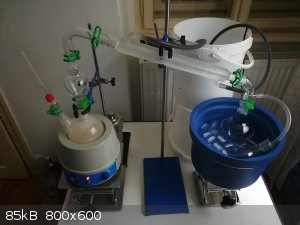 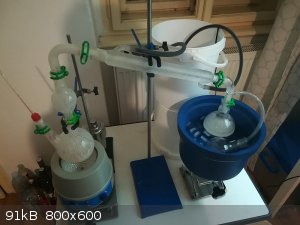
[Edited on 15-11-2018 by nimgoldman]
|
|
|
Refinery
Hazard to Others
  
Posts: 371
Registered: 17-2-2014
Member Is Offline
Mood: Still
|
|
I recently tested making ammonia solution with sodium hydroxide, urea and water according to Nurdrage. The reaction goes slow and steady when the
reaction flask is heated, and it will eventually exhaust and (apparently) a sodium carbonate residue will remain.
I bubbled ammonia through solution and its SG was 0.888, or about 32%.
Considering urea and lye in bulk are cheap, 1-2 bucks per kg, several kg of ammonia can easily be produced. This gas can be either dissolved in water,
or used directly as is, dried if necessary.
Condensing it into liquid ammonia is another thing, though. If I were in need, I would obtain a reefing unit that goes down to -50C and install a
CaCl2 bath and a collection vessel that is sealable(a gas cylinder) in it. Any evaporation residue from the cold trap can be further led into water as
per the first procedure in order to eliminate losses and ammonia vapors. Actually, a common propane cylinder will handle ammonia easily, their
operational pressure is 8bar nominal and safety valve is set at 35bar. Ammonia generates 35bar at 60-70C.
[Edited on 28-5-2020 by Refinery]
|
|
|
Fluorite
Hazard to Others
  
Posts: 132
Registered: 26-12-2018
Location: United Arab Emirates
Member Is Offline
|
|
I don't have a funnel can I use a syringe as a suck-back trap?
How can I know if the syringe will react with ammonia like PET?
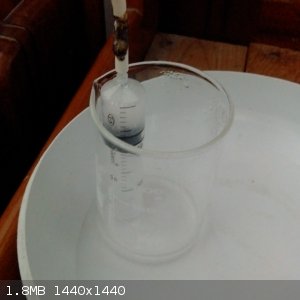
|
|
|
vano
National Hazard
   
Posts: 661
Registered: 22-3-2019
Location: Georgia
Member Is Offline
|
|
Quote: Originally posted by Fluorite  | I don't have a funnel can I use a syringe as a suck-back trap?
How can I know if the syringe will react with ammonia like PET? |
Fluorite, this syringe is made of polypropylene. As long as I remember it does not turn white like PET, so you can use it. Instantly the reaction will
not go away anyway. I keep ammonia in a PET bottle. When the bottle is too thin and can be opened then I put it in another bottle. It can be stored
like this for about two months. Is it possible to buy concentrated ammonia solution in Tunisia? Or other chemicals?
|
|
|
Fluorite
Hazard to Others
  
Posts: 132
Registered: 26-12-2018
Location: United Arab Emirates
Member Is Offline
|
|
Vano.kavt no but I can simply buy calcium ammonium nitrate and added calcium hydroxide to make ammonia
Why don't you use a 5L glass bottle like this? Very cheap actually 4$ here (13~ TND) I'll use this to store my 40% ammonia (I hope)
I'm really excited cause I bought glassware yesterday! But I don't know how to lead the gas from the generator? I don't trust corks and lab supplier
didn't have anyyyyy distillation adapter or stopper so I taped another syringe to 500ml flask but when it gets hot my hot glue melts
Old photo when I didn't have a flask and used a glass bottle in sand bath but didn't work at all
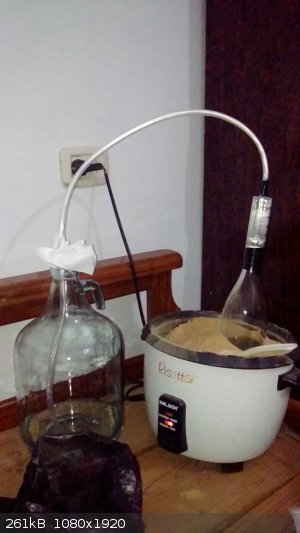
|
|
|
vano
National Hazard
   
Posts: 661
Registered: 22-3-2019
Location: Georgia
Member Is Offline
|
|
Quote: Originally posted by Fluorite  | Vano.kavt no but I can simply buy calcium ammonium nitrate and added calcium hydroxide to make ammonia
Why don't you use a 5L glass bottle like this? Very cheap actually 4$ here (13~ TND) I'll use this to store my 40% ammonia (I hope)
I'm really excited cause I bought glassware yesterday! But I don't know how to lead the gas from the generator? I don't trust corks and lab supplier
didn't have anyyyyy distillation adapter or stopper so I taped another syringe to 500ml flask but when it gets hot my hot glue melts
Old photo when I didn't have a flask and used a glass bottle in sand bath but didn't work at all
|
13 Tunisian dinar equal 15 Georgian Lari. I can buy 3-4 similar ones. But I am lazy and I put in whatever bottle I have, somewhere I have a lot of
HDPE and LDPE bottles. I always thought that it would be as easy to buy chemicals in Tunisia and North Africa in general as in my own country. If you
know the situation in Algeria and Morocco, is it possible to buy reagents there?
[Edited on 1-1-2021 by vano.kavt]
|
|
|
vano
National Hazard
   
Posts: 661
Registered: 22-3-2019
Location: Georgia
Member Is Offline
|
|
I do not know exactly, but. If people make wine at home in Tunisia. Then there will be shops where, for example, they will have potassium
metabisulfite to kill bacterias in wine and many other compounds. The shops for winemakers also have thorium nitrate pentahydrate here(I have no idea
what they are used for, hopefully not in wine production) and it is worth a try in your county.
|
|
|
Fluorite
Hazard to Others
  
Posts: 132
Registered: 26-12-2018
Location: United Arab Emirates
Member Is Offline
|
|
Well it depends I can but 36% H2SO4 3TND, baryte! A lot of Barium sulfate here, toluene, acetone, formaldehyde 40%, very clear HCL, but stupid
hydrogen peroxide is expensive 3TND for 70ml bottle, and 20TND 20% urea solution but you can find tcca, na dcca, NaOH etc...
|
|
|
vano
National Hazard
   
Posts: 661
Registered: 22-3-2019
Location: Georgia
Member Is Offline
|
|
I have never seen low concentrated acids. Sulfuric acid is always 99%. I can buy 50% peroxidee for 2 dollars. It is good that they are still selling.
But sell barium nitrate or chloride instead of sulfate. Insoluble salt Who the hell wants. Probably use in agriculture, whether or not they were sold.
|
|
|
Fyndium
International Hazard
    
Posts: 1192
Registered: 12-7-2020
Location: Not in USA
Member Is Offline
|
|
For the record, urea and sodium hydroxide will produce close to quantitive yields of ammonia in a controlled manner. Have used it many times already
for producing large amounts of ammonia.
|
|
|